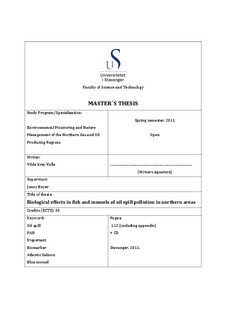| dc.contributor.author | Valle, Vilde Krey | |
| dc.date.accessioned | 2011-10-06T08:29:49Z | |
| dc.date.available | 2011-10-06T08:29:49Z | |
| dc.date.issued | 2011 | |
| dc.identifier.uri | http://hdl.handle.net/11250/182448 | |
| dc.description | Master's thesis in Environmental technology | en_US |
| dc.description.abstract | The oil and gas activities in the northern region have showed an increase over the last years. This year a new field, Skrugard, was discovered in the Barents Sea and the two parliaments in Norway and Russia confirmed the official delimitation line in the former “grey zone” area. As a result of this, the oil and gas activities in this area are only expected to grow.
Chemical dispersants are used in oil spill clean-up processes. It dissolves the oil into smaller particles so it dissolves more easily into the water column. The dispersant makes it easier for the oil to form smaller particles or droplets that are dispersible in the water column. When the oil goes into the water column it is more available to the organisms living there, like fish and mussels. The oil and gas reservoirs in the northern areas like the Barents Sea are located closer to shore than in the southern parts of Norway. If there was an oil spill in this region, the use of chemical dispersant can be necessary in order to prevent it for reaching the shoreline since the oil has a shorter time/distance to be weathered.
In this thesis Atlantic salmon and blue mussels were exposed to oil with and without the present of chemical dispersant agent. The dispersant used in this study was of the same type that were used in the Gulf of Mexico after the Deep Water Horizon accident, Corexit 9500. The objective was to study the effect of the dispersant chemical in relation to uptake and effects of oil in fish and mussels. The result from the exposure time showed that it was a statistically significant difference in the uptake of pollutant in Atlantic salmon in the oil-exposed groups with and without chemical dispersant agent compared to the reference group. However it was not detected a statistically significant difference between the oil-exposed group without chemical dispersant compared to the oil-exposed group with chemical dispersant. In general is seems as the oil-exposed group without chemical dispersant had a higher response than the oil-exposed group with chemical dispersant. The effects study of mussels showed an increasing trend in the groups exposed to oil with and without chemical dispersant compared to the reference group, however this was not statistically proven. | en_US |
| dc.language.iso | eng | en_US |
| dc.publisher | University of Stavanger, Norway | en_US |
| dc.relation.ispartofseries | Masteroppgave/UIS-TN-IMN/2011; | |
| dc.subject | oil spill | en_US |
| dc.subject | PAH | en_US |
| dc.subject | dispersant | en_US |
| dc.subject | biomarker | en_US |
| dc.subject | atlantic salmon | en_US |
| dc.subject | blue mussel | en_US |
| dc.subject | teknisk miljøvern | en_US |
| dc.subject | petroleumsteknologi | en_US |
| dc.title | Biological effects in fish and mussels of oil spill pollution in northern areas | en_US |
| dc.type | Master thesis | en_US |
| dc.subject.nsi | VDP::Technology: 500::Environmental engineering: 610 | en_US |
| dc.subject.nsi | VDP::Technology: 500::Rock and petroleum disciplines: 510::Petroleum engineering: 512 | en_US |
